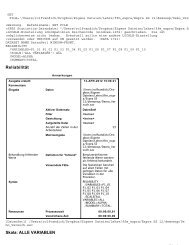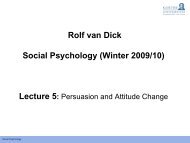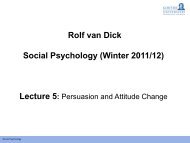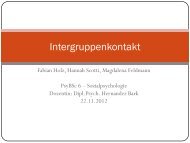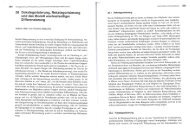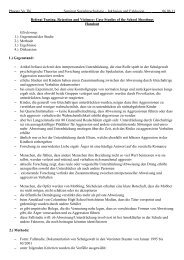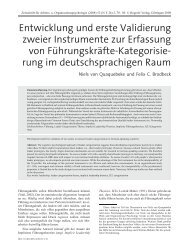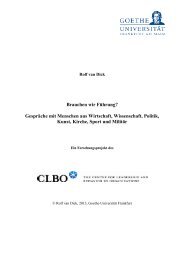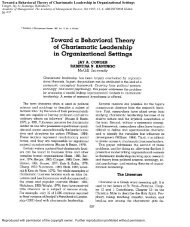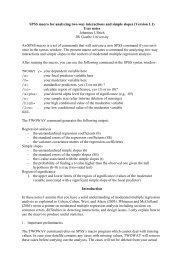Social Identity Theory and Self-categorization Theory: A Historical ...
Social Identity Theory and Self-categorization Theory: A Historical ...
Social Identity Theory and Self-categorization Theory: A Historical ...
Create successful ePaper yourself
Turn your PDF publications into a flip-book with our unique Google optimized e-Paper software.
212 <strong>Social</strong> <strong>Identity</strong> <strong>Theory</strong> <strong>and</strong> <strong>Self</strong>-<strong>categorization</strong> <strong>Theory</strong><br />
them fairly, but Rabbie <strong>and</strong> colleagues showed that participants favour<br />
the outgroup when they believe their own outcomes are controlled by<br />
the allocations of outgroup members (Rabbie, Schot, & Visser, 1989).<br />
Furthermore, work by Yamagishi suggests that assumptions about independence<br />
are critical to social exchange, <strong>and</strong> that when participants in a<br />
minimal groups study are told explicitly that their outcomes are independent<br />
of the allocation decisions of others, evidence for ingroup bias disappears<br />
(Karp, Jin, Yamagishi, & Shinotsuka, 1993).<br />
Rabbie <strong>and</strong> colleagues (e.g., Rabbie & Horwitz, 1988) went on to argue<br />
that social identity theory fails to adequately distinguish between social<br />
categories <strong>and</strong> social groups as dynamic entities. They propose an alternative<br />
model (behavioural interaction model; Rabbie & Lodewijkx, 1996) that<br />
explores how individuals – through interdependence of goals, outcomes,<br />
<strong>and</strong> needs – grow to develop a sense of ‘groupness’ or ‘entitativity’ with<br />
others. Rather than being in competition, however, many theorists now<br />
see the behavioural interaction model as being a more fine-grained<br />
analysis of a process already accounted for by social identity theory. Perceptions<br />
of interdependence are clearly of central importance in group<br />
behaviour, but can be seen as part of a wider social identity mechanism<br />
where people use information such as interdependence to construct<br />
social categories (see Gagnon & Bourhis, 1996; Perreault & Bourhis,<br />
1998; Rabbie & Lodewijkx, 1996; Turner, 1999; Turner & Bourhis, 1996,<br />
for instalments in this debate).<br />
During the late 1980s <strong>and</strong> early 1990s, there was growing realization<br />
that the integrity of the social identity approach did not rest on the<br />
integrity of the minimal group paradigm. Rather than being used a raison<br />
d’etre for the theory, the paradigm instead became a tool for testing the<br />
specific hypotheses proposed by the theory. When one reviews the literature<br />
on intergroup relations prior to the 1970s, it is striking how little<br />
experimental work was actually done on intergroup relations. One reason<br />
for this is that the existing paradigms were seen to be ill-suited to capturing<br />
the complexity of intergroup dynamics, <strong>and</strong> attempts to do so (e.g., Sherif’s<br />
camp studies) were epic <strong>and</strong> expensive field studies. In the context of this,<br />
the minimal group paradigm was a revelation because it allowed people<br />
to examine intergroup behaviour in a highly controlled (<strong>and</strong> cheap) way.<br />
What followed was a plethora of lab-based research using participants<br />
in either minimal or ad hoc groups. The goal of much of this research was<br />
to test Tajfel’s arguments about the so-called ‘socio-structural’ variables;<br />
the notion that intergroup behavior was largely determined by people’s<br />
subjective impressions of where they lie in the status/power hierarchy, <strong>and</strong><br />
their impressions of the permeability, stability, <strong>and</strong> legitimacy of that<br />
hierarchy. The results of these studies were in line with the theory. Upon<br />
examining permutations of status, power, legitimacy, permeability, <strong>and</strong><br />
stability, one could make reasonably strong predictions as to how much<br />
intergroup bias they would show, <strong>and</strong> how they rationalized or managed<br />
© 2008 The Author <strong>Social</strong> <strong>and</strong> Personality Psychology Compass 2/1 (2008): 204–222, 10.1111/j.1751-9004.2007.00066.x<br />
Journal Compilation © 2008 Blackwell Publishing Ltd




